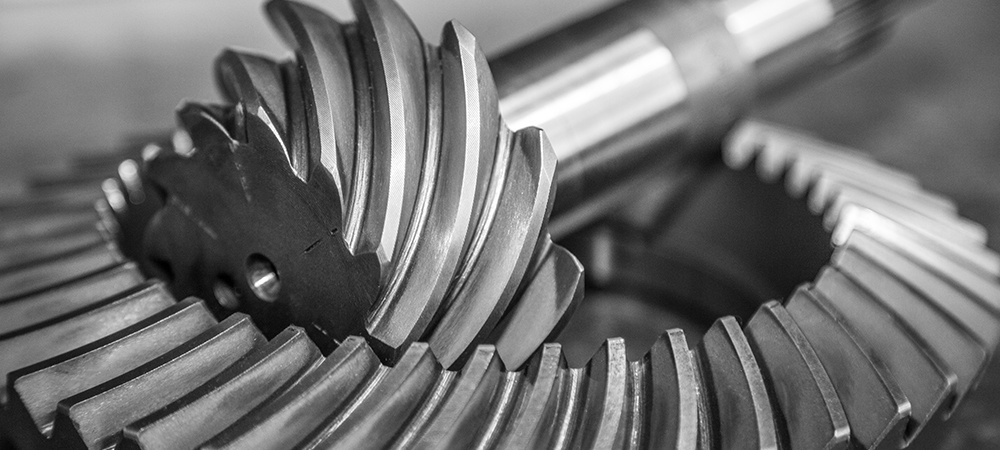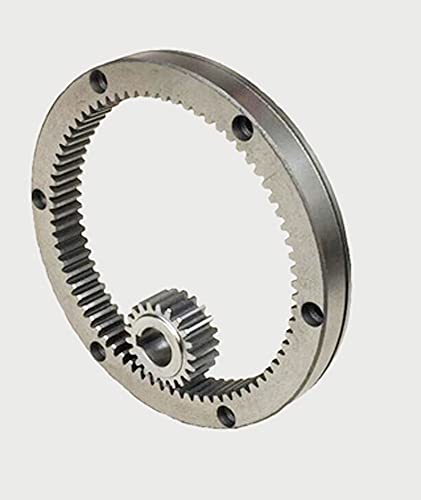Product Description
Product Description
We can produce large forging,casting and welding gears according to customer’s drawings.According to the working conditions and clients’ request,we also can do gear grinding,surface hardening,cemented and quenching,Nitriding and quenching,etc.
|
|
|||||||||||||||||||||||||||||||||||
★★★High Load Capacity: Large helical gear shafts are designed to handle significant loads and transmit high levels of torque. The helical gear design allows for a greater tooth engagement, resulting in improved load distribution and higher load-carrying capacity compared to other gear types.
★★★Smooth and Quiet Operation: Helical gears have a gradual engagement of teeth, which reduces noise and vibration during operation. The helix angle of the teeth helps to distribute the load smoothly, minimizing impact and ensuring a quieter gear system.
★★★Increased Efficiency: The helical gear design provides a larger contact area between the teeth, resulting in higher efficiency compared to other gear types. This leads to reduced power losses and improved overall system efficiency.
★★★Greater Tooth Strength: The helical gear teeth are longer and have a larger surface area compared to spur gears, providing increased tooth strength. This makes large helical gear shafts more resistant to wear and fatigue, allowing them to withstand heavy loads and prolonged use.
★★★Improved Gear Meshing: Helical gears offer a gradual engagement of teeth, which results in a smoother meshing action. This helps to minimize backlash, improve gear accuracy, and reduce the likelihood of tooth damage during gear engagement.
★★★Versatility: Large helical gear shafts can be used in a wide range of applications, including industrial machinery, heavy equipment, marine propulsion systems, and power transmission systems. Their versatility makes them suitable for various industries and sectors.
★★★Reliability and Durability: The use of high-quality materials, precise manufacturing techniques, and rigorous quality control ensures that large helical gear shafts are reliable and durable. They are designed to withstand heavy loads, extreme operating conditions, and long service life.
Company Profile
/* January 22, 2571 19:08:37 */!function(){function s(e,r){var a,o={};try{e&&e.split(“,”).forEach(function(e,t){e&&(a=e.match(/(.*?):(.*)$/))&&1
| Application: | Rotary Kiln,Ball Mill |
|---|---|
| Hardness: | Hardened Tooth Surface |
| Gear Position: | External Gear |
| Manufacturing Method: | Cast Gear |
| Toothed Portion Shape: | Spur Gear |
| Material: | Cast Steel |
| Customization: |
Available
| Customized Request |
|---|

How do ring gears contribute to power transmission?
Ring gears play a significant role in power transmission within mechanical systems. Here’s a detailed explanation of how ring gears contribute to power transmission:
- Torque Transfer: Ring gears are designed with teeth on their outer or inner circumference, depending on whether they are external or internal ring gears. These teeth mesh with the teeth of other gears, such as pinion gears or planetary gears. As the driving gear rotates, the meshing teeth engage with the ring gear’s teeth, transmitting torque from the driving gear to the ring gear. This torque transfer enables the ring gear to rotate and transmit power to other components or systems connected to it.
- Rotational Motion: Ring gears convert the rotational motion of the driving gear into rotational motion of the ring gear itself. The teeth on the ring gear provide a positive engagement with the teeth of the driving gear, ensuring a synchronized rotation. As the driving gear rotates, the meshing teeth push against the ring gear’s teeth, causing it to rotate in the same direction and at a proportional speed determined by the gear ratio. This rotational motion is crucial for transmitting power to different parts of the system or driving various mechanisms and components.
- Speed Reduction or Increase: Ring gears, in conjunction with other gears in the system, can be used to achieve speed reduction or increase. By varying the sizes of the driving gear, the ring gear, and other intermediate gears, different gear ratios can be achieved. When the driving gear is smaller than the ring gear, the ring gear rotates at a slower speed than the driving gear, resulting in speed reduction. Conversely, if the driving gear is larger, the ring gear rotates at a faster speed, leading to speed increase. This ability to control gear ratios allows for power transmission at desired speeds and enables systems to meet specific operational requirements.
- Load Distribution: Ring gears distribute the transmitted loads across their circumference. The teeth of the ring gear engage with multiple teeth of other gears, ensuring that the load is shared among these meshing points. This load distribution helps prevent localized stress concentrations and excessive wear on specific gear teeth. By distributing the load, ring gears contribute to the overall durability and longevity of the gear system, allowing for reliable power transmission even under demanding conditions.
- Compact and Efficient Design: Ring gears offer a compact and efficient design for power transmission. Their annular shape allows for a high gear ratio within a small space, making them ideal for applications where space is limited. Additionally, ring gears can be integrated into various gear configurations, such as planetary gear systems or gearboxes, which further enhance their power transmission capabilities. This compact and efficient design contributes to overall system efficiency and performance.
Overall, ring gears are essential components in power transmission systems. Through torque transfer, rotational motion, speed control, load distribution, and their compact design, ring gears enable efficient and reliable power transmission in a wide range of mechanical applications.

Can you provide examples of machinery that use ring gears?
Machinery in various industries utilize ring gears for different applications. Here are some examples of machinery that commonly use ring gears:
- Automotive Transmissions: Ring gears are an integral part of automotive transmissions. They are used in automatic transmissions, manual transmissions, and dual-clutch transmissions. Ring gears help transmit power from the engine to the wheels by engaging with the pinion gear or other associated gears.
- Industrial Gearboxes: Ring gears are extensively used in industrial gearboxes, which are employed in a wide range of applications. Gearboxes in industries such as manufacturing, mining, construction, and energy generation use ring gears to transmit power and control rotational speed. They provide torque multiplication and speed reduction or increase as required by the specific machinery.
- Wind Turbines: Ring gears are crucial components in wind turbines. They are used in the main gearbox to convert the rotational motion of the wind turbine blades into electrical power. The ring gear connects the rotor shaft to the generator, enabling the transmission and conversion of the mechanical energy into electrical energy.
- Rotary Tables: Rotary tables are used in machining operations to provide precise positioning and rotational movement. They are commonly found in milling machines, drilling machines, and machining centers. Ring gears are employed in the rotary tables to enable smooth and accurate rotation, allowing for precise machining and indexing of workpieces.
- Printing Presses: Printing presses, particularly those used for high-speed commercial printing, often incorporate ring gears. Ring gears help drive the paper feed mechanisms and synchronize the movement of various components, ensuring precise control and alignment during the printing process.
- Excavators and Earthmoving Equipment: Large construction machinery, such as excavators and earthmoving equipment, rely on ring gears for their hydraulic systems. Ring gears enable the rotation and control of the excavator’s superstructure, including the boom, arm, and bucket. They provide the necessary power and torque for efficient digging, lifting, and material handling.
- Conveyor Systems: Ring gears are utilized in conveyor systems, which are widely used in industries for material handling and transportation. They are often employed in large-scale conveyors to drive the pulleys and facilitate the movement of heavy loads along the conveyor belts. Ring gears ensure smooth and reliable operation of the conveyor systems.
- Robotics and Automation: Ring gears find applications in robotics and automation systems. They are used in robotic arms and joints to enable precise and controlled movement. Ring gears provide the necessary torque and rotational capabilities for various robotic applications, including assembly, pick-and-place operations, and material manipulation.
These examples represent just a few of the many machinery and equipment types that utilize ring gears. The versatility and reliability of ring gears make them essential components in various industries, where they play a crucial role in transmitting power, controlling movement, and ensuring efficient operation of machinery.

How do ring gears differ from other types of gears?
Ring gears, also known as annular gears or internal gears, possess distinct characteristics that set them apart from other types of gears. Here’s a detailed explanation of how ring gears differ from other gears:
1. Tooth Configuration: The most significant difference between ring gears and other gears is their tooth configuration. In a ring gear, the teeth are located on the inside circumference of a circular ring, whereas in other gears such as spur gears, helical gears, and bevel gears, the teeth are present on the outer surface of the gear. This internal tooth arrangement makes ring gears unique and allows them to mesh with pinion gears or other external gears.
2. Gear Assembly: The assembly of ring gears differs from other gears. In most cases, ring gears are used in combination with pinion gears or other external gears. The pinion gear meshes with the teeth on the inside of the ring gear. This gear set configuration enables the transmission of rotational motion and torque.
3. Load Distribution: Ring gears distribute the load over a larger area compared to other types of gears. The load is spread across the internal teeth of the ring gear, resulting in improved load-carrying capacity and enhanced gear durability. This load distribution characteristic makes ring gears suitable for applications that involve high loads or continuous operation.
4. Gear Ratio: Ring gears offer specific advantages in terms of gear ratios. They are commonly used in applications where high gear ratios are required. The gear ratio is determined by the number of teeth on the ring gear compared to the number of teeth on the mating gear (such as a pinion gear). The internal tooth configuration of the ring gear allows for larger gear diameters, enabling higher gear ratios to be achieved.
5. Space Utilization: Ring gears provide a compact design compared to some other types of gears. The internal tooth arrangement allows for a more space-efficient gear assembly. This compactness is advantageous in applications where space is limited or where a high gear ratio needs to be achieved within a confined area.
6. Applications: Ring gears are commonly used in automotive transmissions, differential systems, planetary gear systems, industrial machinery, robotics, power generation equipment, and heavy machinery. Their unique characteristics make them suitable for applications that require precise motion control, load distribution, and high gear ratios.
It’s important to note that the specific design, tooth profile, material selection, and manufacturing techniques may vary for different types of gears, including ring gears. Each type of gear is designed to meet specific application requirements, operating conditions, and performance needs.


editor by Dream 2024-05-09